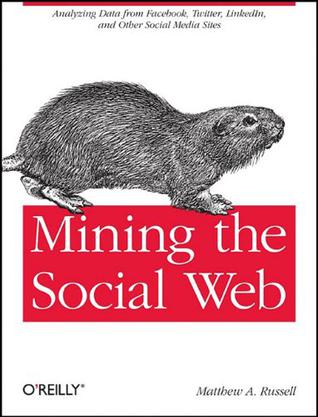欢迎来到相识电子书!
标签:SNS
-
Designing Social Interfaces
Knowing how to create a social website to foster user interaction and community building is becoming a core skill for developers and designers today, but grasping the nuances of the social web is much harder than it appears. With more than 100 patterns, principles, and best practices, this book presents practical design solutions that you can use immediately to create or improve a social website interface. Written by curators of "Yahoo!'s Pattern Library", "Designing Social Interfaces" shares hard-won insights into what works, what doesn't, and why. That includes salient advice for many of the common challenges designers and developers face when building managing social websites. This book will help you: learn basic design patterns for adding a social element to an existing site; reign in misbehaving users on an active community site; build a social experience around a product or service, and invite people to join; develop a social utility without having to build an entirely new infrastructure; enable users of your site's content to interact with one another; and, offer your members the opportunity to connect with each other in the real world. The book also exposes antipatterns: emergent bad practices in the social network and social media space. -
Mining the Social Web
Popular social networks such as Facebook, Twitter, and LinkedIn generate a tremendous amount of valuable social data. Who's talking to whom? What are they talking about? How often are they talking? Where are they located? This concise and practical book shows you how to answer these types of questions and more. Each chapter presents a soup-to-nuts approach that combines popular social web data, analysis techniques, and visualization to help you find the needles in the social haystack you've been looking for -- and some you didn't know were there. With Mining the Social Web, intermediate-to-advanced Python programmers will learn how to collect and analyze social data in way that lends itself to hacking as well as more industrial-strength analysis. The book is highly readable from cover to cover and tells a coherent story, but you can go straight to chapters of interest if you want to focus on a specific topic. Get a concise and straightforward synopsis of the social web landscape so you know which 20% of the space to spend 80% of your time on Use easily adaptable scripts hosted on GitHub to harvest data from popular social network APIs including Twitter, Facebook, and LinkedIn Learn how to slice and dice social web data with easy-to-use Python tools, and apply more advanced mining techniques such as TF-IDF, cosine similarity, collocation analysis, document summarization, and clique detection Build interactive visualizations with easily adaptable web technologies built upon HTML5 and JavaScript toolkits This book is still in progress, but you can get going on this technology through our Rough Cuts edition, which lets you read the manuscript as it's being written, either online or via PDF. via http://oreilly.com/catalog/9781449394844/ Amazon: http://www.amazon.com/Mining-Social-Web-Finding-Haystack/dp/1449388345/ -
Social Circles
Businesses are starting to operate in the world of the social web, but most have a very poor understanding of social interaction, and its huge impact on how successful their endeavors will be. It is much more complicated than just business blogs or official company Twitter accounts. Most of people's interactions with each other and with brands happen offline, away from computers, and often away from mobile phones. What people do offline has a huge impact on what they do online. Social Circles, by lead researcher for social media Paul Adams, is about helping business understand this offline/online relationship. Research has shown time and again how people have multiple independent circles of friends, all of whom they trust in different ways, and all of whom wield varying degrees of influence. People are using social networks to interact with people they already know offline, and not to make new connections with people they don’t know. They are recreating their offline social circles online. Understanding these social circles is the key to successful behavioral advertising. -
社会化媒体营销大趋势
面对社交网络尤其是微博的流行,企业如何应对?本书是作者多年从事网络营销实战的总结,揭示了社会化媒体如何改变了营销和企业运营的规则,系统总结了社会化媒体营销及新营销,介绍了各种不同的社会化媒体,包括社交网络、微博、博客、视频、百度百科、BBS 等,并对如何在实际工作中应用众多社会化媒体工具给出了具体的指导。涉及到社会化媒体的定义、新营销策略、营销方法论、社会化媒体营销评估、移动互联网与新营销、社会化媒体与商业。 对中国的广大企业来说,本书所讲述的内容非常有价值,可以帮助企业通过社会化媒体营销提升销售业绩、品牌美誉度。本书适合对社会化媒体、网络营销、电子商务感兴趣,想低成本在网上销售、推广的读者,尤其适合大专院校网络营销及电子商务专业的学生、 网络营销从业人员、向互联网化转型的传统企业 -
社会网分析讲义
《社会网分析讲义》编辑推荐:社会网分析是社会网理论在建立模型与实证研究时,收集定量资料与测量社会网变量必需的工具。 -
伊托邦
当前正在全球兴起的数字网络是一种能极大改变城市面貌的基础设施。这一全新的基础设施将产生新型的社会关系,以此为基础,一种更加智能化的新型城市将得以创建。本书深入探讨了数字网络对我们未来城市生活的影响,系统阐述了属于数字时代的新型城市——伊托邦——在经济、社会和文化等方面的内涵与意义。 -
决胜SNS
本书系统全面地介绍了SNS的概念和理论基础、SNS的发展和现状、SNS热点产品及其设计、开放平台、APP应用开发、SNS网站的运营、SNS应用的整合、社会化营销的引入等内容,包括关于媒体化的未来、盈利模式的未来、移动互联网上的SNS的探讨。 本书面向不同层次的SNS从业人员,致力于帮助他们了解并发现由SNS所带来的变革和契机,无论是SNS运营者、产品设计人员还是APP开发人员、网络营销人员都能找到自己感兴趣的内容。 本书适用于SNS网站运营者、互联网产品设计人员、APP开发人员、网络营销人员以及其他互联网从业人员,也可以作为各大中专院校相关专业师生的参考用书和相关培训机构的培训教材。 目 录 第1章 探求SNS的本源 1 1.1 SNS的基本概念 1 1.2 SNS的价值 3 1.3 SNS的基础理论 4 1.3.1 六度分割理论 4 1.3.2 150法则 6 1.3.3 弱链接 7 1.4 SNS的根本 9 1.4.1 现实社会与SNS 9 1.4.2 SNS的行为成本 10 1.4.3 SNS中弱链接的本质 12 第2章 SNS之前生今世 13 2.1 早期SNS的发展 13 2.1.1 早期的BBS 13 2.1.2 基于Web的BBS论坛 14 2.1.3 早期交友网站 15 2.2 另一个互联网入口 16 2.3 各具特色的SNS网站 17 2.3.1 综合性SNS 17 2.3.2 婚恋SNS 23 2.3.3 商务SNS 24 2.3.4 垂直主题SNS 25 2.3.5 媒体化的SNS 26 2.3.6 社会化商务 29 2.3.7 更广泛的SNS应用——豆瓣 30 2.4 SNS与社区 31 第3章 聚具人气的SNS产品及其设计 33 3.1 SNS聚集用户的利器 33 3.1.1 建立好友关系 34 3.1.2 信息流(生活流) 35 3.1.3 日志•迷你博客•相册•小组 37 3.1.4 羽量级的Social Game 39 3.1.5 百花齐放的应用 44 3.2 强调用户体验与SEO 45 gduo3.2.1 基于用户体验的网站设计 45 3.2.2 提高SNS网站的搜索排名 45 3.3 留住用户的页面设计 48 3.3.1 重视色彩所传递的语言 49 3.3.2 选择合适的页面布局 50 3.3.3 运用栅格系统 57 3.4 页面结构化带来的高效 59 3.4.1 区分内容与表现 59 3.4.2 常用内容的结构化 61 3.4.3 结构化过程中的注意事项 67 3.5 无处不在的CSS布局 68 3.5.1 框模型(Box Model) 68 3.5.2 元素类型 72 3.5.3 浮动与版式 73 3.5.4 相册列表的外观实现 81 3.6 常用功能的结构化与CSS设定 92 3.6.1 滑动门导航菜单 92 3.6.2 选项卡 98 3.6.3 投票结果显示 102 3.6.4 固定在浏览器内的菜单 106 第4章 开放平台的力量 111 4.1 开放平台引发的变革 111 4.2 使用SNS平台开放的API 115 4.3 国内开放平台的现状 116 4.4 开发者对API的期望 119 4.5 SNS应用开发基础 119 4.5.1 信息存储 120 4.5.2 信息交换 121 4.6 又拍网的应用开发 122 4.6.1 Yupoo API简介 123 4.6.2 使用Yupoo API 123 4.7 豆瓣网的应用开发 129 4.7.1 豆瓣API简介 129 4.7.2 使用豆瓣API 130 4.8 饭否网的应用开发 144 4.8.1 饭否API简介 144 4.8.2 使用饭否API 144 4.8.3 完整程序代码与运行实例 155 4.9 Google系列产品的API应用 167 4.9.1 Google Talk的API应用 168 4.9.2 Google Maps的API应用 172 4.10 Facebook的APP开发 174 4.10.1 Fackbook的开放平台 175 4.10.2 开发一个Facebook应用程序 177 4.10.3 Facebook应用程序平台的优点 189 第5章 SNS运营的十八般武艺 189 5.1 SNS的运作模式 190 5.1.1 关系建立与维系的基本元素 190 5.1.2 Networking与Network 192 5.2 SNS网站的决胜之道 195 5.3 整合SNS应用之手 197 5.3.1 一个Mashup应用例子 197 5.3.2 Mashup及其典型应用 199 5.3.3 Mashup技术解读 199 5.3.4 Mashup面临的挑战 201 5.4 SNS与个人Blog的互渗 202 5.4.1 将SNS插入到Blog 202 5.4.2 让Blog成为一个小型SNS──Google Friend Connect 213 5.5 不可回避的运营困惑 219 5.5.1 盈利困境 219 5.5.2 社交关系的无效与无序 220 5.5.3 信息爆炸问题 221 5.5.4 安全问题 222 5.5.5 用户疲惫 224 第6章 社会化营销的引入 225 6.1 社会化媒体(Social Media)的概念 226 6.2 为什么要社会化营销 231 6.3 如何进行社会化营销 238 6.4 社会化营销案例 240 6.4.1 Dell的社会化营销 240 6.4.2 “封杀王老吉” 243 6.4.3 Blendtec视频营销 244 6.4.4 失败的兰蔻玫瑰社区网络营销 245 6.4.5 悦活果汁在开心网的营销 246 6.5 社会化营销的问题 247 第7章 SNS之最终幻想 250 7.1 社交关系与信息的未来 250 7.2 媒体化的未来 252 7.3 盈利模式的未来 254 7.3.1 广告 254 7.3.2 虚拟增值服务 258 7.3.3 应用分成与联合运营 259 7.4 移动互联网上的SNS 260 7.5 开放平台的未来 262 7.5.1 开放的应用平台 262 7.5.2 终极的去中心化SNS 263 -
社会资本
林南将社会资本理论放在资本理论(古典资本理论与新古典资本理论)的体系之中,详细阐述了社会资本的要素、命题和理论发现,介绍了研究计划与研究议程,对个体行动与社会结构之间的互动意义进行了理论说明(在对首属群体、社会交换、组织、制度转型和数码网络的论述中)。林南开创性地提出并且令人信服地解释了为什么“你认识谁“和“你知道什么“在生活与社会中具有重要意义。 -
社交网站界面设计
《社交网站界面设计》提供100多种模式、原则以及最佳实践,并针对在设计社交网站时经常遇到的问题给出明确建议。本书将提供给你培养用户交互习惯和构建社区最具价值的参考。 本书作者将与你分享难得的经验,教会你平衡各种不同的因素,并与你的用户共同构建和谐健康的网络社区。 本书教会你 掌握创建任何网站时都会用到的原则 学习基本设计模式,以便向现有的网站中添加新的社交组件 学会在活跃的社区网站管控好行为不端的用户 围绕一个产品或一项服务构建社交体验,并让用户参与其中 无须构建一个全新的架构就可以开发出一套实用的社交应用 让你的网站上的用户可以互动 为你的会员提供离线联系的机会 识别和避免采用反模式——社交网络和社交媒体空间产生的最糟实践 -
正在爆发的营销革命
博客、网络站点和其他社会网络为企业提供了具有巨大潜力的产品和服务营销渠道。但如何充分利用它们呢?通过阅读本书,你可以理解社会网络技术是如何发挥功效的,还可以学到一些最有效和实用的方法,帮助你将营销的触角延伸到经常访问这些站点的人们。 本书作者是社会媒体和病毒式营销领域的专家,作者避开了花哨的描写和行话,为读者提供了明智的建议以及在社会网络上进行业务定位的策略,同时提供了案例分析,介绍了其他公司是如何使用这种方法的。 本书将帮助你: 研究博客和微博客,发现如何应用像Twitter这样的网站来建立品牌知名度。 学习对话营销的艺术,以及坦诚和透明的态度在发展社会媒体中的作用。 通过社会网络来管理和提高在线声誉。 进入越来越有影响力的视频和播客市场。 通过学习其他营销者的尝试来发现哪些策略有效,哪些无效。 今天,许多消费者都利用Web作为一种表达观点的途径。本书演示了如何参与对话、如何为社区做出贡献,以及如何为产品或服务招揽顾客。 -
社会网络与组织
本书是一本跨越社会学和管理学的论著。全书对组织社会网络领域的主要概念进行了言简意赅的介绍。书中阐明了网络研究方法的基本原理,探讨了目前存有争议的主要论题?“指出了理论发展的方向,同时对一些想当然的假设给予了强有力的批判。 本书是为所有试图学习并在组织研究中运用社会网络方法的人而著。书中对这一方法做了清晰、易懂而又生动有趣的介绍,并对一直受忽视的组织中人际网络问题给予了特别关注。 -
Connected
Your colleague's husband's sister can make you fat, even if you don't know her. A happy neighbor has more impact on your happiness than a happy spouse. These startling revelations of how much we truly influence one another are revealed in the studies of Drs. Christakis and Fowler, which have repeatedly made front-page news nationwide. In CONNECTED, the authors explain why emotions are contagious, how health behaviors spread, why the rich get richer, even how we find and choose our partners. Intriguing and entertaining, CONNECTED overturns the notion of the individual and provides a revolutionary paradigm-that social networks influence our ideas, emotions, health, relationships, behavior, politics, and much more. It will change the way we think about every aspect of our lives. -
筑巢引凤
不论你是在建立什么样的网站,让用户之间产生良好交互都是成功的关键所在。你的目标在于让用户热烈谈论你的应用,邀请好友访问它,抱怨它,赞美它,从方方面面来分析它。设计阶段就要牢记这些目标,让社会交互帮你引导用户注册,吸引他们不断地回头光顾,并主动介绍其他人也来使用它。 社会化网站设计不只是增添新功能,还必须深入理解用户的社会交互,从而有针对性地进行设计,为方便这种交互铺平道路。这是决定网站成败的关键因素之一。 本书列举了大量真实互联网世界的界面的例子,结合社会心理学的基本理论,深入浅出地介绍了设计优秀的社会化网站的具体策略。你将学到: •用户参与线上交互的真实原因及心理; •使用周期——用户使用网站的整个过程和不同阶段的特点; •万事开头难,如何引导用户跨过第一道门槛——注册; •如果新发布的网站无人光顾,你该如何应对; •怎样分析你的网站的用户及流量的效益; •如何让你的网站为更多人爱用。 -
社会网络分析导论
本书通过文献研究和社会调查,以马克思主义工人阶级理论为指导,着力研究在市场化进程中我国国有企业职工不同群体的现实状况、利益关系,分析企业内部分化的效率意义、分化过程中的矛盾及其分化的趋势。 “社会网络分析”发端于20世纪30年代,成熟于20世纪70年代,是一种新的社会学研究范式。本书将“社会网络分析”看做是一门对社会关系进行量化分析的艺术和技术,全面介绍和评析了“社会网络分析“的基本概念和方法,对于我国在 ”社会网络分析”领域的研究,具有一定的指导意义和前瞻性。 -
关系管理的智慧
《关系管理的智慧:NQ风暴》读者对象:经济学、管理学研究教学工作者,党政企事业单位领导干部,理论宣传工作者,中外企业经营者及中高层经营人员。 -
社会网络分析法
社会是一个由多种多样的关系构成的巨大网络。如何研究关系?视角当然多种多样,既可以像林语堂的小说中描述的那样对关系进行细致的刻画,又可以像黄光国等社会心理学家那样对人情、面子和关系网进行质的描述,更可以用社会网络分析法对关系进行量化的表征,从而揭示关系的结构,解释一定的社会现象。社会网络分析的意义在于,它可以对各种关系进行精确的量化分析,从而为某种中层理论的构建和实证命题的检验提供量化的工具,甚至可以建立“宏观和微观”之间的桥梁。 本书就像一本手册,引导读者进入社会网络分析的研究领域。它既适用于社会网络分析的初学者,也适用于对社会网络分析有所了解的人士。 -
正在爆发的互联网革命
短短20年里,互联网经历了门户网站和Web 2.0时代的重大变革,如今已经迈入社会化网络时代。新一轮的互联网革命即将爆发,而其影响已经开始…… 本书详细介绍了SNS(社会化网络)的起源和理论模型、SNS发展的三波浪潮,以及Facebook、Twitter、校内网、开心网和51等国内外各大主流SNS网站的发展历程和成功秘诀;全面阐述了SNS将对我们的生活、工作、学习、娱乐方式产生的颠覆性影响;透彻地分析了SNS与各种传统互联网经营模式相结合后会带来的变革和机遇,以及SNS开放平台的“长尾效应”和它对整个互联网产业的影响和重大意义;最后,对SNS在3G移动互联网时代的前景进行了分析和预测,同时对SNS的未来进行了展望,描绘了一幅美好的SNS时代全景图。 -
网络、群体与市场
过去十年来,现代社会中复杂的连通性向公众展现出与日俱增的魅力。这种连通性在许多方面都有体现并发挥着强大的作用,包括互联网的快速成长、全球通信的便捷,以及新闻与信息(及传染病与金融危机)以惊人的速度与强度传播的能力。这种现象涉及网络、动机和人们的聚合行为。网络将人们的行为联系起来,使得每个人的决定可能对他人产生微妙的后果。 本书是本科生的入门教材,同时也适合希望进入相关领域的高层次读者。它从交叉学科的角度出发,综合运用经济学、社会学、计算与信息科学以及应用数学的有关概念与方法,考察网络行为原理及其效应机制。以深入浅出的方式描述了在网络的作用下正在浮现与发展起来的一些交叉学科领域,讨论了社会、经济和技术领域相互联系的若干基本问题。本书是一本带你跨入信息科学和社会科学交叉领域研究之门的优秀参考书。 -
Cognitive Surplus
The author of the breakout hit Here Comes Everybody reveals how new technology is changing us from consumers to collaborators, unleashing a torrent of creative production that will transform our world. For decades, technology encouraged people to squander their time and intellect as passive consumers. Today, tech has finally caught up with human potential. In Cognitive Surplus , Internet guru Clay Shirky forecasts the thrilling changes we will all enjoy as new digital technology puts our untapped resources of talent and goodwill to use at last. Since we Americans were suburbanized and educated by the postwar boom, we've had a surfeit of intellect, energy, and time-what Shirky calls a cognitive surplus. But this abundance had little impact on the common good because television consumed the lion's share of it-and we consume TV passively, in isolation from one another. Now, for the first time, people are embracing new media that allow us to pool our efforts at vanishingly low cost. The results of this aggregated effort range from mind expanding-reference tools like Wikipedia-to lifesaving-such as Ushahidi.com, which has allowed Kenyans to sidestep government censorship and report on acts of violence in real time. Shirky argues persuasively that this cognitive surplus-rather than being some strange new departure from normal behavior-actually returns our society to forms of collaboration that were natural to us up through the early twentieth century. He also charts the vast effects that our cognitive surplus-aided by new technologies-will have on twenty-first-century society, and how we can best exploit those effects. Shirky envisions an era of lower creative quality on average but greater innovation, an increase in transparency in all areas of society, and a dramatic rise in productivity that will transform our civilization. The potential impact of cognitive surplus is enormous. As Shirky points out, Wikipedia was built out of roughly 1 percent of the man-hours that Americans spend watching TV every year. Wikipedia and other current products of cognitive surplus are only the iceberg's tip. Shirky shows how society and our daily lives will be improved dramatically as we learn to exploit our goodwill and free time like never before. -
Here Comes Everybody
A revelatory examination of how the wildfirelike spread of new forms of social interaction enabled by technology is changing the way humans form groups and exist within them, with profound long-term economic and social effects-for good and for ill A handful of kite hobbyists scattered around the world find each other online and collaborate on the most radical improvement in kite design in decades. A midwestern professor of Middle Eastern history starts a blog after 9/11 that becomes essential reading for journalists covering the Iraq war. Activists use the Internet and e-mail to bring offensive comments made by Trent Lott and Don Imus to a wide public and hound them from their positions. A few people find that a world-class online encyclopedia created entirely by volunteers and open for editing by anyone, a wiki, is not an impractical idea. Jihadi groups trade inspiration and instruction and showcase terrorist atrocities to the world, entirely online. A wide group of unrelated people swarms to a Web site about the theft of a cell phone and ultimately goads the New York City police to take action, leading to the culprit's arrest. With accelerating velocity, our age's new technologies of social networking are evolving, and evolving us, into new groups doing new things in new ways, and old and new groups alike doing the old things better and more easily. You don't have to have a MySpace page to know that the times they are a changin'. Hierarchical structures that exist to manage the work of groups are seeing their raisons d'tre swiftly eroded by the rising technological tide. Business models are being destroyed, transformed, born at dizzying speeds, and the larger social impact is profound. One of the culture's wisest observers of the transformational power of the new forms of tech-enabled social interaction is Clay Shirky, and Here Comes Everybody is his marvelous reckoning with the ramifications of all this on what we do and who we are. Like Lawrence Lessig on the effect of new technology on regimes of cultural creation, Shirky's assessment of the impact of new technology on the nature and use of groups is marvelously broad minded, lucid, and penetrating; it integrates the views of a number of other thinkers across a broad range of disciplines with his own pioneering work to provide a holistic framework for understanding the opportunities and the threats to the existing order that these new, spontaneous networks of social interaction represent. Wikinomics, yes, but also wikigovernment, wikiculture, wikievery imaginable interest group, including the far from savory. A revolution in social organization has commenced, and Clay Shirky is its brilliant chronicler.
热门标签
下载排行榜
- 1 梦的解析:最佳译本
- 2 李鸿章全传
- 3 淡定的智慧
- 4 心理操控术
- 5 哈佛口才课
- 6 俗世奇人
- 7 日瓦戈医生
- 8 笑死你的逻辑学
- 9 历史老师没教过的历史
- 10 1分钟和陌生人成为朋友




















